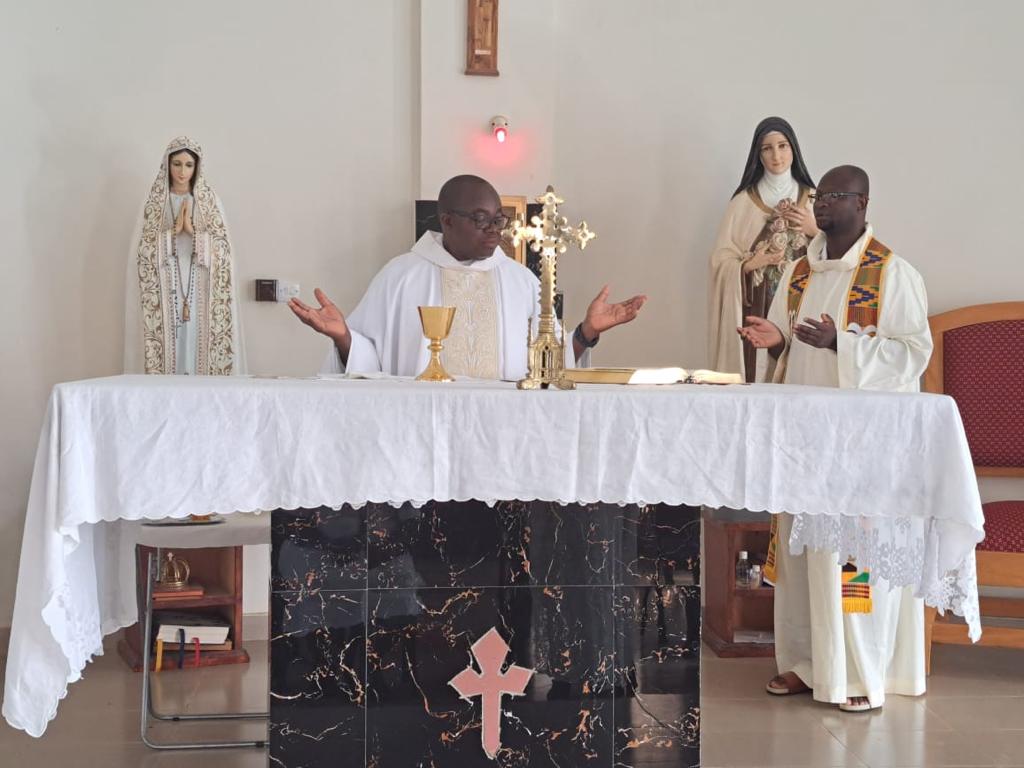
Father Paul Kala was born in Ghana, but in 2010, he was ordained a priest in the Diocese of Springfield, IL. He went back to his country of birth to celebrate a Thanksgiving Mass with his relatives and friends when his life and vocation were forever changed.
“I encountered a lady who, I estimate, was in her late 80s, sitting for a little boy who had no shoes nor clothing beyond his underwear,” Father Paul said. “With only a handful of hairs on his head, tiny arms and legs, and a distorted stomach due to malnutrition, he was trying to quelch his hunger by sucking. on the clay of a termite mound. Can you imagine, being so hungry as a young boy that you have to eat termites and clay?”
Seeing this, Father Pat knew his life would never be the same. “I asked God to lead my path: How could I, as a Christian, as a priest, help change the world? Was there anything I could do to help solve the world’s perennial problem of hunger, both spiritual and physical? Thus, my missionary journey began,” Father Pat said.
Ghana has some 33 million people, an estimated 10 percent of whom are Catholics. In 2018, Ghana was among the ten fastest-growing economies in the world and is currently the second-largest economy in West Africa. But even though the country has made tremendous progress in reducing poverty in recent decades, its success has been uneven, and significant inequalities still exist. A majority of the population in the northern region lives on less than $1 a day – with the poverty line set back in 2011 at $1.90 a day.
Hence, the need for missionary priests such as Father Pat, who, with the permission of Springfield’s Bishop Thomas John Paprocki, has been ministering in Ghana after joining the Society of St. Therese of the Little Flower, also known as the Theresian Fathers, six years ago. Their charism is the evangelization and education of the marginalized in sub-Saharan Africa.
“A typical day for me begins with the celebration of the Holy Mass,” said Father Pat. “After, depending on the season, I either visit families on their farms during the rainy months of May to October or engage with those at home during the dry spell from November to April.”
He painted a vivid picture of his routine at the St. Therese Youth Development and Educational Center (STYDEC) in the village of Kaluri. “We welcome around 120 children daily, providing them with meals, clean water, and education. We also offer religious classes and end the day in prayer.”
STYDEC, established on October 19, 2013, through funds from St. Paul Church in Highland, Illinois, has a dual mission. “We aim to feed both the body and the soul,” he explained. “Education is a way to teach children how to ‘fish’ for themselves in Ghana, breaking the cycle of poverty.”
Yet, Father Pat’s mission isn’t without challenges. “Clean drinking water remains elusive for many,” he laments, contrasting his experience in Springfield, Illinois, with his current reality. “Waterborne diseases like guinea worm, typhoid, and cholera are rampant. Thankfully, with support, we’ve drilled 11 wells in the past three years.”
The cultural landscape presents its own set of trials. “In northern Ghana, girls are often married off young, usually to older men,” says Father Pat. “What’s harrowing is when victims see this practice as ‘normal.’ But there have been rays of hope, like our first female STYDEC graduate in 2021, now an English teacher and mentor.”
Father Pat serves under the Missionaries of St. Therese, with two communities in northern Ghana’s Diocese of Wa. “Our Ave Maria Formation House chapel in Wa was built for 100, but we now see over 400 attendees,” he says, noting the remarkable growth in faith.
Acknowledging the vital role of supporters, Father Pat expresses gratitude: “Our work would be impossible without many friends and benefactors, including Bishop Paprocki and the Diocese of Springfield. Our current priority is to provide clean water, costing $8,000 for a borehole. Additionally, turning STYDEC into a full-fledged Catholic school is on the horizon, with an estimated renovation cost of $150,000 for a 500-student capacity.”
Read more stories in MISSION Magazine


